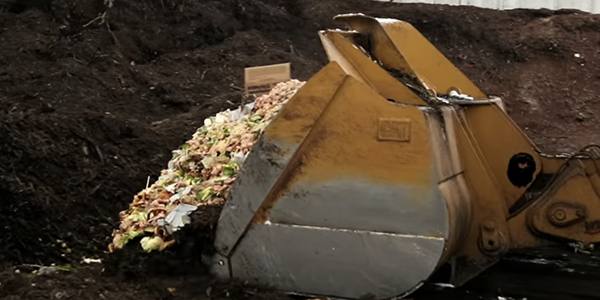The New York State Department of Environmental Conservation (DEC) on Wednesday announced proposed regulations that would require large food scrap generators to donate excess edible food and send scraps to an organics recycler if one is available within 25 miles.
The proposed rulemaking would implement requirements outlined in the state Food Donation and Food Scraps Recycling law with an effective date of Jan. 1, 2022.
The department will hold two virtual public hearings on the draft regulations on April 7 and is taking public comments on the proposal until April 27.
“Reducing food waste has significant environmental benefits, including creating useful compost and decreasing the amount of materials that would otherwise be sent to a landfill, eventually creating methane gas that contributes to climate change,” DEC Commissioner Basil Seggos said in a statement.
The proposal would define a large food scrap generator as an entity that generates an annual average of 2 tons of scraps per week. Exemptions would include, among others, New York City, hospitals, and elementary and secondary schools.
The DEC in December finalized the regulations to reduce greenhouse gas emissions, the first regulatory requirement of the Climate Leadership and Community Protection Act (CLCPA). (See New York Holds Final CLCPA Emissions Hearings.)
In a meeting Wednesday, the New York State Climate Action Council’s (CAC) Waste Advisory Panel discussed the many complicated pathways to food scrap handling and regulation.
The council is working to complete by this fall a scoping plan for achieving the state’s energy and climate goals under the CLCPA, with the various advisory panels due to submit their initial recommendations to the CAC in April.
Dereth Glance, executive director of the nonprofit Onondaga County Resource Recovery Agency, recommended using sewers to convey food waste, at least when practical.
“I want to be aware of unintended consequences, because with everything in waste management, there are trade-offs,” Glance said. “You have to keep that material moving; otherwise you risk public health crises — cholera and dysentery — which is what we’re responsible for avoiding. Waste is more complicated than ‘you put this type fuel in a vehicle and you get this kind of emissions.’”
Jane Gajwani, director of energy and resource recovery programs for the New York City Department of Environmental Protection, said she wouldn’t want to rule out using sewers, but that her department has concerns with collection and processing.
“When food waste reaches the wastewater treatment plant, it doesn’t go directly into the digester; it ends up going through our entire process train, which is really energy-intensive,” Gajwani said. “Instead of converting it to energy, you’re actually using a lot of energy to aerate it and to burn up the organic material. … Even if we can get over the collection system issues, we still would substantially increase the energy usage of the plant.”
Organics and Biogas
DEC Deputy Commissioner Martin Brand, who chairs the Waste Advisory Panel, said “there’s a lot of cross-panel discussion going on regarding organics and biogas.”
“If we’re serious about reducing greenhouse gas emissions and air pollution from trucks, we need to figure out how to optimize local ability to process organics,” said Michelle Oyewole of the New York City Environmental Justice Alliance.
Steve Changaris, the National Waste and Recycling Association’s vice president for the Northeast Region, said that DEC staff will determine the GHG impact of various policy recommendations. For example, if the state recommends further source separation of organics, the waste panel suggests that the state chart the path for an eventual ban on disposal of organics where there is adequate infrastructure to manage it, he said.
But a recommendation for a renewable biogas project to fuel a local municipal or trucking fleet might be rejected by DEC staff as not fitting their model.
“We’re trying to give that information to the experts so they can run those numbers and the CAC will be in a much better position to sort them out,” Changaris said.
“What we’re looking at now is a big job,” said Michael Cahill, partner at law firm Germano & Cahill. “If we’re talking about organics that are going to landfills and going to waste-to-energy now, we’ve got to get a lot of infrastructure built, and we’ve got to have a mindset that is friendly to that.”
It is necessary to factor in what the future infrastructure will be, Brand said.
“Obviously we’re moving away from fossil fuels, moving away from natural gas, moving away from essentially perpetuating that natural gas and fossil fuel infrastructure, so that’s a factor,” Brand said. “We know that infrastructure is enormously complicated and expensive, and the question is, what’s your threshold for maintaining that?”
Resa Dimino of Resource Recycling Systems was concerned that the organics and landfill subgroup might recommend incentivizing energy production from waste.
“That is inconsistent with state policy on renewable energy,” Dimino said. “I think that if we’re going to meet really bold climate goals, we can’t meet them by incentivizing the thing that’s less bad. We need to meet them by going for the thing that’s going to really move us forward, and that is reducing waste and recovering more materials.”
Lauren Toretta, president of Greenwich, Conn.-based CH4 Biogas and leader of the organics diversion and landfill subpanel, disagreed.
“First and foremost, we believe in a reduction of waste, and food should always go to its highest and best use first, whether to feed people or animals,” Toretta said. “But there is always going to be some residual waste.”


